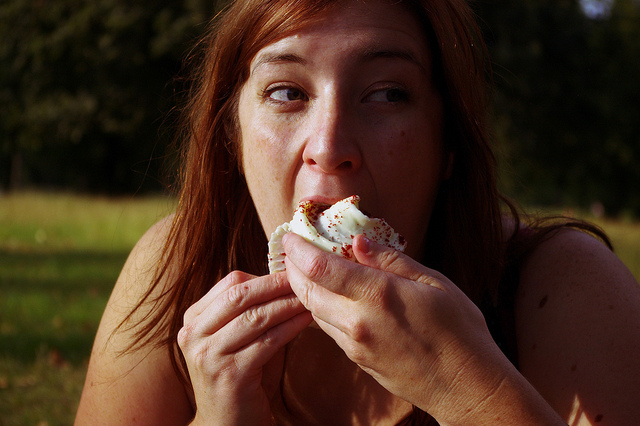Ten years ago, I earned a living as a professional pie and cookie taster.
After midnight when everyone in my household was fast asleep and I felt lonely, restless or bored, instead of journaling about my feelings or having a candle-lit bath or reading a good book, I’d head to the fridge to snack on something unhealthy with too much sugar and bad fats. Probably a cookie or a pie.
Why? Because it was there. It was easy. It was a habit I couldn’t break. And because, I didn’t know it yet, but I was addicted to sugar. And afterward, lo and behold, I’d still feel lonely, restless or bored. And I’d also feel feel guilty for having snacked again after midnight.
In our culture, unhealthy, snacky “comfort” food is often our go-to whenever we feel uncomfortable emotions. We use quick snacks as a substitute for emotional nourishment. What this means is that we snack not out of physical hunger but out of emotional hunger: hunger for love, for connection, for fulfillment or for pleasure.
The problem with emotional eating is that it’s never truly nourishing. One reason is the food we usually snack on is not nutrient-dense, whole food, which leaves our bodies feeling worse off than before. Another reason is our bodies feel deeply dissatisfied because it’s not truly possible to fill an emotional need with food.
As a health coach, many clients turn to me, seeking help around emotional eating.
I help brainstorm healthier alternatives that can provide pleasure and satisfaction instead of defaulting to the unhealthy habit of emotional eating. I suggest finding a way to get what they want without resorting to this type of self-sabotaging behavior.
To do this, I help them come up with non-edible, nourishing ways to meet their emotional needs or cravings. I call this idea the Personal Nourishment Menu. It’s called a “menu” because there are many options from which to choose. This creates a strong sense of empowerment because one is not limited in one’s options.
For example, everything listed on my own Personal Nourishment Menu satisfies a craving for pleasure, relaxation, adventure or sweetness in my life. This started with me recognizing that I deserve to experience pleasure. I deserve to relax. I deserve to have adventures. I deserve sweetness. It took many years of deep soul work for me to embody these realizations.
My Personal Nourishment Menu now includes: massage, a shower, warm clothes out of the dryer, deep conversation, dance, yoga, meditation, reading, journaling and hanging out with my six-year-old daughter.
Most people have default ways of coping that are not healthy. And the reason people turn to destructive behaviors in the first place is for lack of what they perceive as better options. Unfortunately, the best option from a list of destructive options is still destructive.
I call this an impoverished menu of choice. If we only have one or two ways to react in a moment of frustration, we are likely to feel stuck. If we add three, four or 10 choices to the menu, it starts to feel a lot better. Then, we are more able to make choices that have us feeling truly nourished.
So, nowadays, when I tune into my emotions and recognize (because it begins with awareness) that what I’m really craving is personal nourishment (not sugar) instead of turning to an unhealthy snack to avoid feelings of discomfort, I turn to my menu that I’ve written down on a piece of paper and stuck on my fridge. I scan my menu and decide, in the moment, which choice will satisfy what I’m really craving and give myself the gift of that instead.
The main objective of this menu is for me to have supportive choices on hand rather than destructive, default choices. And it’s especially beneficial to have this enriching, non-edible menu when I’m low-resourced like tired, stressed, frustrated or grumpy because that’s when it’s easiest to default to bad habits.
I had sweet proof of this recently when my daughter came up with this strategy all by herself after whining for a quite a while. My reaction was not one of my prettier “mama moments.” I snapped. I couldn’t take it. The whining was relentless; it was worse than nails on a chalkboard.
But then my daughter taught me a most valuable lesson.
Here’s the scenario:
“Argh! Why do you keep whining when you know it doesn’t work?”
“Mama, I’m sorry. Maybe I just need to run around or something.”
“That’s an idea. How about we play tag outside?”
“Okay, Mama.”
(20 minutes later)
“Mama, it worked! I feel better now and I’m not whining! Maybe we should write it down so we don’t forget that playing tag helps me not be grumpy.”
“That’s so helpful love! Thanks for suggesting that. Can we think of some other ideas that we can add to the what-to-do-when-you’re-whining menu?”
“Sure, Mama. I’ll draw pictures for the ideas too in case it’s an emergency grumpy explosion and we don’t have time to read each word because pictures are faster, right?”
And that’s exactly what she did. She drew pictures and came up with eight healthier alternatives to whining, all by herself.
She wrote: “When whining: run, move, swings, play tag, trampoline jumping, puzzle, laugh and tickles.
I was humbled. Apparently she’s got health coaching in her blood.
Author: Stacey Morgenstern
Editor: Catherine Monkman
Photo: Amelia Wells/Flickr







Read 0 comments and reply